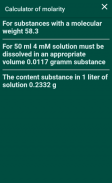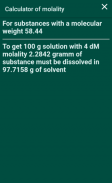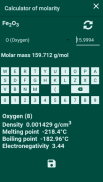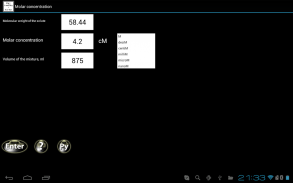











Molarity and molality calculator

Description de Molarity and molality calculator
This free calculator allows you to calculate how much to weigh the material to obtain a solution of desired molarity or molality. Also you can calculate molar mass of substances. App contain Periodic table of elements. The help file provides basic concepts and examples.
Via application knowing the molar mass of solute and the molarity of the solution of the substance can be calculated the amount of solute.
The application can be useful to researchers, students and teachers, especially those specializing in molecular biology, biochemistry, microbiology, genetics, chemistry, etc.
The application can read the results of calculations aloud with text-to-speech engine.
1. In the field "Molar concentration" write the molecular weight of the solute. For example, for NaCl mass of the sodium atom is 22.99, the mass of an atom of chlorine - 35,453, a total molecular weight is about 22.99 + 35.45 = 58.44
The masses of the atoms of simple substances can be found in the periodic table, it is called with the "?" or count in the application (click the "Table" button on the right side of the screen)
2. In the field "Molecular weight of the solute" write the desired molarity. If you need any nanomolar or micromolar solution, the application can use the field selection metric prefixes.
3. In the field "Volume of the mixture, ml" write how much we need a solution.
4. Press "Enter".
5. The application calculates the required weight of the substance.
6. Weigh substance.
7. Solute in a volume of the solvent, a little less than the required amount of solution. When dissolution is complete, bring the volume up to the desired value.
In addition, you can calculate the molality of the solution in the application.
Molality, also called molal concentration, is a measure of the concentration of a solute in a solution in terms of amount of substance in a specified amount of mass of the solvent. This contrasts with the definition of molarity which is based on a specified volume of solution (see Wikipedia)
You can calculate the molar mass inside of application
For example, we need to calculate the molar mass of slaked lime Ca(OH)2
Press icon with table.
Press the key with the first letter of the chemical symbol of calcium - in this case, "C". The program will form a list of all the chemical elements, the symbol of which begins at "C" (for example, it will include carbon, cadmium, etc.)
From the list choose calcium. The program displays it at the top of the screen, and displays various
characteristics of calcium. In the center of the screen appears the inscription "Molar mass XXX g/mol", the molar mass
You can edit the molecular weight of the element, for example, change it for uranium from tabular 238.0289 to 235.0439 - molecular weight of a particular isotope. The change will be during the current session.
We repeat the procedure until we introduce the entire formula of the substance.
You can find help here
http://www.homebear.ru/molar/help_en.php
Privacy policy
http://colorblind.space/polit_win.txt
Cette calculatrice libre vous permet de calculer la quantité de peser le matériau pour obtenir une solution de molarité ou molalité souhaitée. Aussi, vous pouvez calculer la masse molaire de substances. App contient un tableau périodique des éléments. Le fichier d'aide fournit des concepts de base et des exemples.
Via l'application connaissant la masse molaire du soluté et la molarité de la solution de la substance peut être calculée la quantité de soluté.
L'application peut être utile aux chercheurs, aux étudiants et aux enseignants, en particulier ceux qui sont spécialisés dans la biologie moléculaire, la biochimie, la microbiologie, la génétique, la chimie, etc.
L'application peut lire les résultats des calculs à haute voix avec le moteur texte-to-speech.
1. Dans le champ « concentration molaire » écrire le poids moléculaire du soluté. Par exemple, pour une masse de NaCl de l'atome de sodium est 22,99, la masse d'un atome de chlore - 35 453, un poids moléculaire total est d'environ 22,99 + 35,45 = 58,44
Les masses des atomes de substances simples se trouvent dans le tableau périodique, il est appelé avec le « ? » ou compter dans l'application (cliquez sur le bouton « Table » sur le côté droit de l'écran)
2. Dans le champ « poids moléculaire du soluté » écrire la molarité souhaitée. Si vous avez besoin d'nanomolaire ou d'une solution micromolaire, l'application peut utiliser les préfixes de sélection de champ métriques.
3. Dans le champ « Volume du mélange, ml » écrire combien nous avons besoin d'une solution.
4. Appuyez sur « Entrée ».
5. L'application calcule le poids requis de la substance.
6. Pesez substance.
7. soluté dans un volume de solvant, un peu moins que la quantité requise de solution. Lorsque la dissolution est achevée, ramener le volume à la valeur désirée.
De plus, vous pouvez calculer la molalité de la solution dans l'application.
Molalité, également appelée concentration molale, est une mesure de la concentration d'un soluté dans une solution en termes de quantité de substance en une quantité déterminée de masse du solvant. Cela contraste avec la définition de molarité qui est basée sur un volume déterminé de solution (voir Wikipedia)
Vous pouvez calculer la masse molaire à l'intérieur de l'application
Par exemple, nous avons besoin de calculer la masse molaire de la chaux éteinte Ca (OH) 2
Appuyez sur l'icône avec table.
Appuyez sur la touche avec la première lettre du symbole chimique du calcium - dans ce cas, « C ». Le programme formera une liste de tous les éléments chimiques, dont le symbole commence à « C » (par exemple, il comprendra le carbone, le cadmium, etc.)
Dans la liste choisissez calcium. Le programme affiche en haut de l'écran, et affiche diverses
caractéristiques de calcium. Au centre de l'écran apparaît l'inscription « Masse molaire XXX g / mol », la masse molaire
Vous pouvez modifier le poids moléculaire de l'élément, par exemple, changer d'uranium de tableau 238,0289 à 235,0439 - masse moléculaire d'un isotope particulier. Le changement sera au cours de la session en cours.
Nous répétons la procédure jusqu'à ce que nous introduisons la formule complète de la substance.
Vous pouvez trouver de l'aide ici
http://www.homebear.ru/molar/help_en.php
Politique de confidentialité
http://colorblind.space/polit_win.txt


























